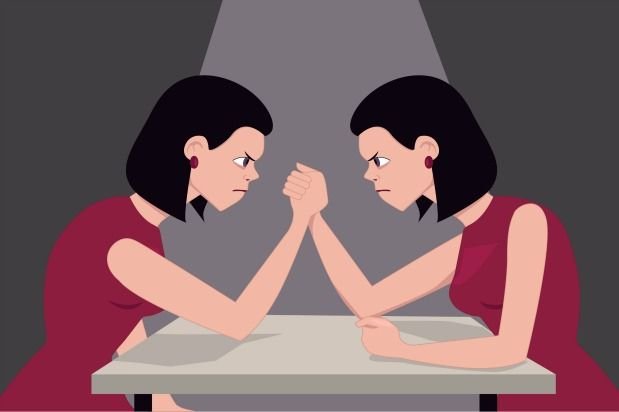No discussion of Self-Parenting would be complete without touching on the concept of “Inner Conflicts.” Truly this is the reason that the Self-Parenting program was originally conceived. Inner Conflicts are the classic reason why you become stuck in your personal goals, whether inner or outer. They are also the core problem for someone who has had a difficult childhood because he or she was never guided to resolve conflicts in a consistent and positive way.
There are many folk wisdoms that illustrate Inner Conflicts. “The Heart is willing, but the flesh is weak.” “I love you, but I’m not ‘in love’ with you.” “I’m not hungry, but I’m still eating this chocolate cake.”
A common experience early practitioners seem to experience is what I call a "inner bashing.” Inside their head is an ongoing conversation that sounds something like this: “You are a bad person [because _____]” then “No you are, you are a bad person [because _____].” This tends to go endlessly back and forth. Here there is not really a conflict of needs other than both selves wanting to yell at and attack each other.
Once you start daily Self-Parenting, this tends to drop away because your Inner Child is finally being heard, listened to and acknowledged for the first time ever. If your Inner Child does want to continue bashing you, simply say, "Thank you Inner Child for telling me that,” and after a while it starts to get tired of this boring tactic.
How Inner Conflicts Develop
Prior in the series we established that within your Inner Conversations there are two main voices, the Inner Parent and the Inner Child. The Inner Child gets most of the attention in recovery circles because it's a fun and low stress topic to talk about. When you don’t really know how your inner conversations work, it’s easy to blame the Inner Child for what looks like emotional problems and excessive behaviors. When people first start Self-Parenting, they typically say something like, "It's my inner child who wants to overeat, smoke and drink itself stupid.”
Yet, within a short period of practice, the practitioner is usually confronted with the reality that their negative style as an Inner Parent is why the Inner Child reacts as it does. The Inner Parent side is where the focus and retraining must take place for progress with the emotional “acting out.” The individual quickly learns that it's the negative Inner Parent who is not following through on creating the right mental environment where substance and emotionally addictive behaviors are no longer needed.
To say this in a simple way, it's very rare that the Inner Child is truly the source of why someone is out of control. Instead, it's typically the Inner Parent’s side, whether through a pattern of abusing the Inner Child or ignoring him/her. This is just like how it works in our outer family dynamics. When a child is abused or ignored with some form of negative outer parenting, it often copes by "acting out,” which is basically an escalating cry for help as the abuse continues.
How many therapists have experienced an exasperated parent bringing in their child with problem behaviors to be “fixed?” Only as they begin working with the child do they eventually realize that it is actually the parent’s negative outer parenting causing the child’s behavioral problems. And what happens when that parent refuses to do the necessary work to change their parenting skills? Sadly for the child, they most often look for another therapist.
The Relationship Seesaw
Here’s the real key: your Inner Parent and Inner Child are exactly equal partners in a relationship that functions much like a seesaw. Each inner self is on its own side. When each self is performing the roles according to their specific side, then the seesaw goes up and down in the proper way. This represents your life moving forward in the ideal manner.
However if one side (or the other) decides they don't want to perform their role on the seesaw anymore, that one side can do a lot to sabotage the smooth functioning of your seesaw represented by your daily chores and goals. This is where inner conflicts come into play.
Each inner self is equal, however each self has specific and different needs. For the seesaw to function correctly each self has to perform on its side to help the other self. If either side isn’t happy, they will tend to balk and the relationship will gradually become more and more dysfunctional.
The Warning Signs
You typically notice an inner conflict when you have had the exact same inner conversation for 3 days, 3 weeks, or 3 months in a row. It’s a decision you just can’t seem to make. It could be as simple as which clothes to wear for an important interview, where to go on vacation or which bill do we have to pay first.
You can have an inner conflict about any outer situation. Whose house do we go to for the family celebrations? What major in college should we spend the next two years pursuing? Which computer to buy? Why are you not happy with the person you are dating when things started out so well?
Signs of Inner Conflicts typically surface with body feelings. You are overly tired yet you just slept all night. You are getting strange headaches for no reason, or experiencing a sharp "gut feeling" that something isn't right. Perhaps you were trying to achieve an important task or goal and no matter how hard you try you just can't get motivated or energized. This would be an inner conflict.
A Win/Win Solution
The key to solving an Inner Conflict is recognizing that both inner selves have specific needs. An effective resolution involves ensuring that both sides get their needs met. When this happens it is known as a Win/Win solution. Unfortunately there are three other possible ways to resolve an Inner Conflict. One is Win/Lose, when the Inner Parent gets its needs met, but not the Inner Child. Another is Lose/Win, when the Inner Child is happy but the Inner Parent is not. And worst of all, the Lose/Lose where neither self is happy in any way.
In the Self-Parenting Program we have an eight-step procedure to resolve inner conflicts. Each step is crucial in that you go through each step as a sequence. You begin by defining your inner conflict, then determining the needs of each self and finally having both selves strategize together to get their needs met.
Just like family members or countries can have outer conflicts that go on for weeks, months, or years, you can have an inner conflict which if you don't resolve, will simply continue.
One caution, learning to truly resolve Inner Conflicts in a Win/Win manner is a learned skill. It takes at least 15 to 20 formal Inner Conflict Resolutions before the typical practitioner is able to confidently create a Win/Win outcome between the Inner Parent and Inner Child. If this were easy, everyone would be doing it.
In next week’s article, I will break down each of the 8 Steps for Resolving Inner Conflicts. Life is hard enough without your two inner selves fighting with each other. Following each of the 8 Steps in a row will teach your Inner Parent how to create consistent win/win solutions for ongoing Self-Parenting happiness. If you or someone you know is seeking professional help, please visit our directory of counseling and therapy centers or call 866-606-0182 to start the path to recovery today.
Missed Dr. Pollard's previous articles on the basics of self parenting? You can check them out here.
***
John K. Pollard, III, is the author and creator of the book, SELF-PARENTING: The Complete Guide to Your Inner Conversations. His book, published in 1987, became an international bestseller in the US and Australia. What began as a simple discovery over thirty years ago has now become the SELF-PARENTING Program used by practitioners around the world.







